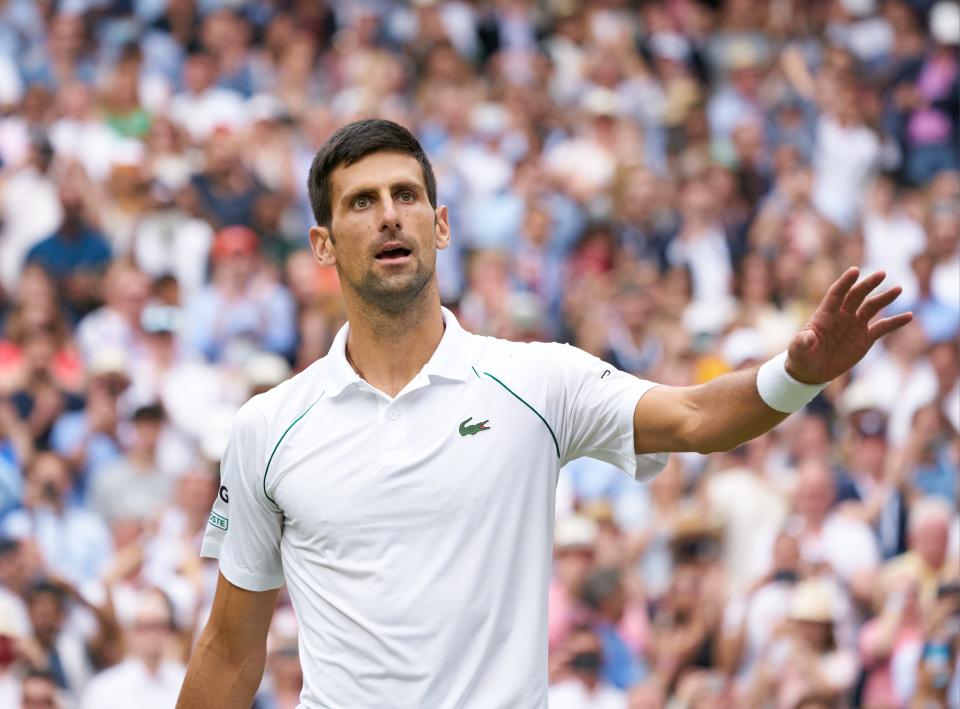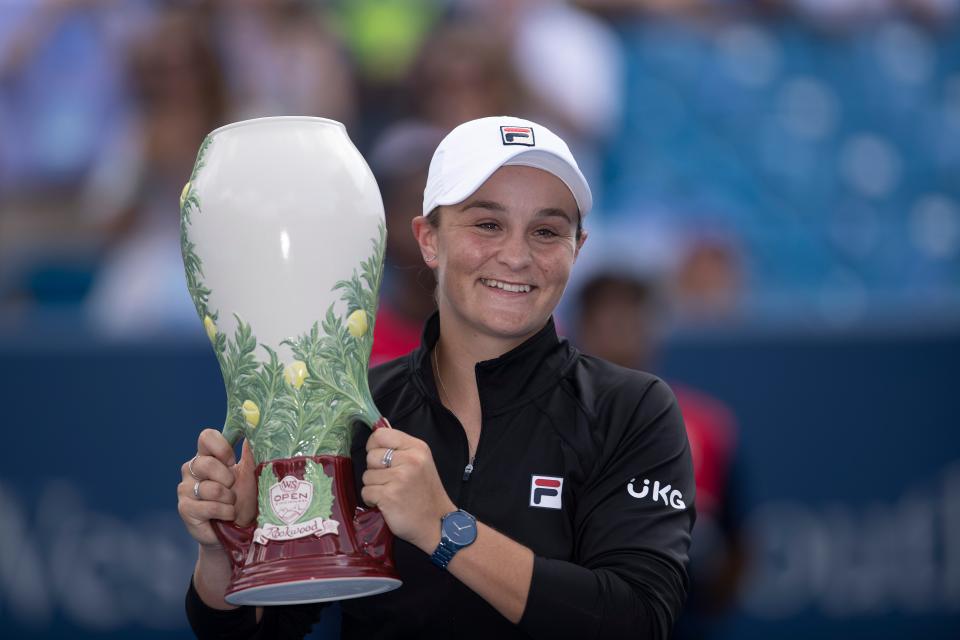Breaking down the U.S. Open draw: No. 1-ranked Novak Djokovic is going for history
When the U.S. Open begins next week, many of tennis’ most beloved players will be sitting at home nursing injuries, including Roger Federer, Rafael Nadal and Serena Williams. Other prominent names like 2020 champion Dominic Thiem and 2016 winner Stan Wawrinka also were forced to withdraw.
But the focus on who isn’t going to be in New York began to shift on Thursday when the draws were released, giving way to a potentially historic tournament where all eyes will be on No. 1-ranked Novak Djokovic.
After winning the first three Grand Slam titles this year to tie Federer and Nadal with 20 in his career, Djokovic could in one fell swoop pass them both for the all-time record and match Rod Laver’s achievement of winning all four tournaments in 1969.

At the same time, next generation threats like Alexander Zverev, Daniil Medvedev and Stefanos Tsitsipas have been surging this year. All three have come close to winning their maiden Grand Slam title and could finally break through in New York.
Meanwhile, after a difficult year off the court, Naomi Osaka will try to rebound at the tournament where she feels most comfortable and reassert herself as the world’s top player.
Here are the four key questions for both the men’s and women’s field coming out of the draw:
Where are the danger spots for Djokovic?
With Djokovic skipping the entire North American hardcourt swing, it’s unclear what kind of form he’s in right now as he tries to complete the calendar year Grand Slam. Djokovic looked exhausted at the end of the Olympics, where he lost back-to-back matches to Zverev and Pablo Carreño Busta, and he clearly needed a break. Was a month off enough to get right physically? Was it too much?
Djokovic may need to play his way into form in the early rounds, and the good news is there shouldn’t be too much trouble for him the first week. Things could get more complicated starting in the fourth round, possibly against Aslan Karatsev, who beat Djokovic on clay earlier this year. He could also face a competitive quarterfinal against either Hubert Hurkacz or Matteo Berrettini, who played well against Djokovic in the Wimbledon final.
But the marquee match of the tournament for Djokovic would likely come in the semifinals against Zverev, who rides into the U.S. Open on an 11-match winning streak including the Olympic gold medal and the title in Cincinnati.
Zverev, who lost last year’s final to Thiem in a fifth-set tiebreak, is playing the best tennis of his life at the moment and has beaten Djokovic three times, including twice on hard courts. The next step for Zverev is doing it in a best-of-five set match.
Who’s the favorite for the women’s title?
Though Osaka is a two-time champion and has been the best player in the world on hard courts, her sporadic participation on the WTA Tour for much of this year has allowed Australian Ashleigh Barty to solidify the No. 1 ranking and truly assert herself as a dominant all-surface player.
Whereas Osaka has played just nine matches in the last five months, Barty is putting together a remarkable season winning four titles, including Wimbledon and two significant hard court tournaments in Miami and Cincinnati.

Barty isn’t as big of a favorite as Serena Williams in her prime, but she’s definitely separated herself from the pack, particularly with Osaka not showing much form lately and other typical contenders like Bianca Andreescu, Simona Halep and Jennifer Brady struggling through injury-plagued seasons.
Osaka, seeded No. 3, did not get the easiest draw. She could face veteran Kaia Kanepi, who has been a Grand Slam upset specialist, in round three. In the fourth round, she’s likely to face either Coco Gauff or 2016 champion Angelique Kerber, who has been playing very well this summer.
One interesting quirk in women’s tennis is that there have been 12 different semifinals at the three Grand Slams played this year, indicating how deep the field is and how unpredictable these tournaments can become.
What are the most watchable first-round matches?
As soon as the draw came out, it was clear that no first-round match would have more star power than former champion Andy Murray and current No. 3 Stefanos Tsitsipas. In reality, it would be a surprise if Murray, currently ranked No. 114, was able to pose many problems for Tsitsipas at this stage of their careers, but perhaps he can put together a vintage performance at Arthur Ashe Stadium.
Who's ready for this Round 1 blockbuster? 🙋♂️@steftsitsipas and @andy_murray will meet for the first time in their careers!#USOpen pic.twitter.com/DjF8zS31x8
— US Open Tennis (@usopen) August 26, 2021
Beyond that, the men’s draw has a few tasty offerings, including John Isner vs. 20-year old Brandon Nakashima in an all-American matchup that we saw recently in Atlanta when Isner won the final 7-6, 7-5.
Cameron Norrie, who has had a very solid year and is up to No. 29 in the world, will take on 18-year-old Spanish phenom Carlos Alcaraz, who is making his U.S. Open debut. Nick Kyrgios, who pulled out of this week’s tournament in Winston-Salem with an injury and hasn’t played much tennis period during the pandemic, is still in the draw and scheduled to face Roberto Bautista Agut.
On the women’s side, Sloane Stephens and Madison Keys — who played each other in the 2017 final — are both unseeded this year and drew each other in the first round. Kerber has an interesting first-round match against Dayana Yastremska, a former top-25 player who was recently reinstated after a successful appeal of a positive test for doping. Garbiñe Muguruza, a two-time Grand Slam champion, has a very tough first-round draw in Donna Vekic, a former top-20 player who reached the quarterfinals at the U.S. Open two years ago.
Where could we see upsets?
Zverev’s quarter of the draw has a lot of upset potential. One reason is that Denis Shapovalov, who would face Zverev in the quarterfinals if the seeds hold, has played quite poorly since his breakthrough semifinal appearance at Wimbledon. That could open the door for an American — either No. 22 seed Reilly Opelka or perhaps 21-year- old Sebastian Korda — to make a deep run. For Korda, a second-round match against two-time U.S. Open semifinalist Carreño Busta would be one of the biggest opportunities of his career to date.
Jannik Sinner, the super-talented 20-year-old Italian who is up to No. 16 in the rankings, also looms as a threat in that part of the draw. He won the Washington, D.C., title earlier this month and would be a very dangerous opponent for Zverev in the fourth round. To get there, he might have to beat Gael Monfils, who has played better lately after going through a deep post-pandemic funk.
In the women’s draw, the quarter led by No. 2 seed Arena Sabalenka could be the place where chaos reigns. Sabalanka is a boom-or-bust type of player who usually busts in the Grand Slams, and a third-round matchup with fiery American Danielle Collins could turn into a nightmare for her. Collins has had a great summer, going 12-2 on hard courts with a couple of titles.
The other big names in that quarter — Victoria Azarenka, Barbora Krejcikova and Muguruza — all look vulnerable based on recent form. It could be wide open for someone like Collins or perhaps No. 20 seed Ons Jabeur to make the semifinals.
This article originally appeared on USA TODAY: US Open draw: Can Novak Djokovic win calendar year Grand Slam?

